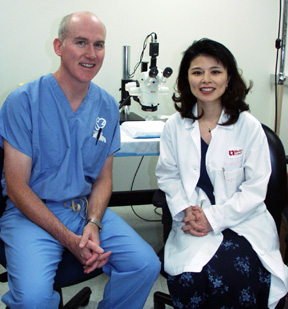 An enzyme involved in aortic aneurysms was identified by investigators from the surgery department including Wanfen Xiong, M.D., Ph.D., assistant professor, and Timothy Baxter, M.D., professor.
An enzyme involved in aortic aneurysms was identified by investigators from the surgery department including Wanfen Xiong, M.D., Ph.D., assistant professor, and Timothy Baxter, M.D., professor.
Their work was published in the Jan. 16 edition of the Journal of Biological Chemistry.
A product of macrophages, the enzyme, MT1-MMP, is released at injury sites to help the healing process. But, when diseases exist such as atherosclerosis, the enzymes may be released over a prolonged period of time and actually become part of the disease process.
Drs. Xiong and Baxter found that MT1-MMP degrades the protein elastin in the vessel wall, leaving it brittle like a stretched-out rubber band.
 |
Timothy Baxter, M.D., left, and Wanfen Xiong, M.D., Ph.D. |
An aortic aneurysm is an abnormal bulge or “ballooning” in the wall of an artery, which may burst from the weakening of the vessel wall. Currently, the only way to treat aortic aneurysms is by surgical intervention. Drs. Xiong and Baxter research ways to detect aneurysms earlier and treat them with drugs before surgical repair is necessary.
Their research is funded by a $1.5 million grant from the U.S. Department of Health and Human Services. They are seeking a renewal to continue this research
“Our goal is to develop medical treatments for small aneurysms, as well as markers to identify them at earlier stages,” Dr. Baxter said. “Doing that would lower the anxiety levels of patients with small, but growing aneurysms and improve the medical outcomes of this common and potentially deadly disease.”
The research has applications such as emphysema, skin diseases, arthritis and dementia, Dr. Baxter said.
Have research that’s about to be published? Let us know. Send a note to today@unmc.edu about your research, the publication it will appear in and the date it’s set to run and we’ll feature it in an upcoming Research Notes.